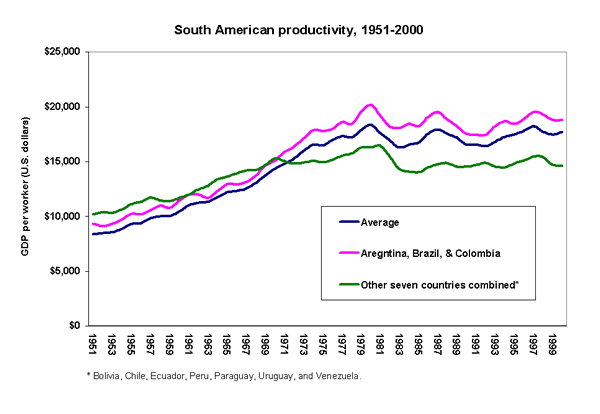See Snapshots Archive.
Snapshot for November 2, 2005.
Washington Consensus leads to productivity stagnation in South America
The Fourth Summit of the Americas will convene on November 4, 2005 in Mar del Plata, Argentina. This summit brings together presidents from governments from throughout North, Central, South America as well as the Caribbean to address the common challenges facing them. The summit’s theme is “Creating Jobs to Fight Poverty and Strengthen Democratic Governance.”
While this focus is welcome, it will fail unless there is clear agreement on the need for a sharp break with the economic orthodoxy that has prevailed in Latin America over the past quarter century. During that time, these economies were largely governed by the tenets of the so-called “Washington Consensus.” The exact parameters of the Washington Consensus exist in the eye of the beholder, but there are common broad elements that all agree form its central philosophy: fiscal austerity, tax reform, interest rate liberalization, privatization (including foreign takeovers of domestic companies and resources), deregulation of product, labor, and financial markets, and trade liberalization. These policies were pushed as a way to increase economic growth and productivity in developing economies. Inarguably, these policies have failed to deliver.
One example of this failure is outlined in the accompanying chart, which shows productivity (GDP per worker) for 10 of South America’s economies (Argentina, Brazil, Bolivia, Chile, Colombia, Ecuador, Peru, Paraguay, Uruguay, and Venezuela).1

Productivity in these countries grew by an average of 2.8% from 1951 to 1975. Between 1975 and 1985, nearly every one of these countries had embraced parts of the Washington Consensus (spurred both by the international financial institutions like the World Bank and the International Monetary Fund and by local elites). From 1985 to 2000, the rate of productivity growth declined to 0.37% annually. This pattern was true both for the group of the largest economies (Argentina, Brazil, and Colombia, which together account for 75% of total GDP in this group) and for the smallest (the remaining seven economies), as shown in the chart.
At this summit meeting, policy makers will be handed a document titled “Labor’s Platform for the Americas” (LPA). The LPA lays out an alternative set of principles and guideposts that should shape future economic policy making in the Americas. (For more details, read EPI’s Issue Brief, Reclaiming an Economic Future Through Democracy.) The bedrock principle of the LPA is the right of nations to form economic policies through democratic processes and to engage in policy autonomy and experimentation. It ought to be taken seriously by the hemisphere’s top policy makers when they meet in Mar del Plata and when they go home.
This week’s Snapshot was written by EPI economist L. Josh Bivens.
Notes
1. All data are from the Penn World Tables. The “average” productivity figure is weighted by the population of each country.
